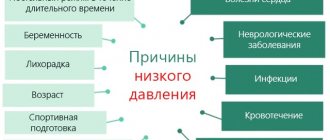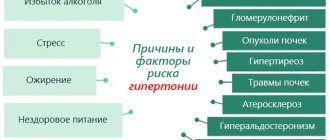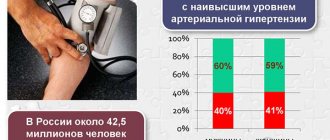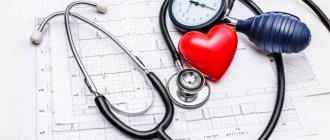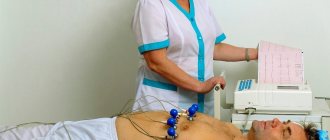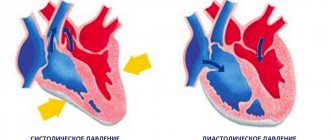An adequate level of blood pressure has long been considered 120 per 80 mmHg. This belief exists in the minds of ordinary people without much medical knowledge.
Is this really the only possible indicator or is it still a variant of the clinical norm? We can say that the second is true.
The World Health Organization has long defined a range of normal values, taking into account the average level of blood pressure at which people feel acceptable and do not experience health problems.
However, the indicated blood pressure indicator of 90 to 50 is never considered adequate if only healthy adults are taken into account.
90 to 45 or 90 to 50 is a pathological condition called hypotension.
Actually, low pressure doesn't mean much. The process is never isolated and primary. There is always one pathology or another that causes such a significant decrease in blood pressure. A thorough examination for diseases is necessary.
What information should a patient obtain in order to promptly pay attention to his health?
Is 90/50 pressure adequate in different cases?
When assessing the adequacy of such an indicator, you need to take into account a lot of factors. Among them are gender and age characteristics, general health status, hormonal levels and some other points. We should consider them in more detail.
Children, teenagers
For children under 8-9 years of age, a blood pressure level of 90 to 50 is quite normal, but if we are talking about the youngest patients, it may even be elevated. Children have their own norm, you need to talk about this with a pediatric cardiologist.
For teenagers the situation is different. In most cases, this level of blood pressure is acceptable, but not desirable.
The age of 12-19 years is the phase of puberty: a very complex state from a physiological point of view. Your health worsens, your blood pressure fluctuates and can be either low or high during the day.
It is extremely difficult to manage such patients, since there is no clear clinical picture.
A thorough examination and correction of the condition in extreme cases is necessary. In most clinical situations, you don’t need to do anything; everything goes away on its own at a certain point.
In the elderly
Hypotension in elderly patients is an extremely rare phenomenon, indicating problems with the cardiovascular system. This is not an absolute truth, but a common occurrence.
Hypertension is more common in old age. That is, the reverse process, an increase in blood pressure, sometimes to levels leading to a hypertensive crisis.
Patients of this kind need to be carefully monitored and therapy must be constantly adjusted. Conducting early screening for pathologies of the cardiovascular system is the key to a normal quality of life.
During pregnancy
Hypotension in pregnancy is common. Even at such a pronounced level. There is no need to do anything; in rare cases, if your health does not allow you to live a full life, it is recommended to contact a specialist.
Endocrine factors
In healthy patients with normal hormonal levels, an upper pressure of 90 may be normal. A diastolic level of 45-50 is always pathological. It is necessary to understand the situation. Perhaps this is due to hormonal imbalances.
Features of the manifestation of hypotension
Hypotension occurs in people of different ages and genders with their own characteristics.
Among women
Hypotension most often develops in women after 30 years of age. It is interesting that this condition develops in mental workers, teachers, managers, and bank employees. Their work requires high nervous tension and is associated with stressful situations, which affects blood pressure.
Also, female hypotension is associated with the craze for fashionable diets for weight loss, which also leads to loss of strength and hypotension. Low blood pressure in women develops against the background of hormonal changes in the body in older age during menopause. There may be periodic decreases in blood pressure with large blood losses during menstruation. Hypotension can develop due to physical overload in female athletes, as well as in the opposite situations, with physical inactivity.
Hypotension in pregnant women deserves special mention. If a pregnant woman’s blood pressure drops to 90/50, then she should urgently seek medical help. First of all, with such pressure, the developing fetus suffers because it lacks oxygen, which can lead to serious consequences in its development.
Placental starvation at such pressure leads to fetal hypoxia, it begins to choke and, if the situation is not changed, its death and miscarriage are possible. Against the background of oxygen starvation, the woman’s body also suffers; so-called gestosis – “painful pregnancy” – can develop, that is, pathological changes occur in organs (kidneys, liver, brain) that can threaten the woman’s life.
Attention! Preeclampsia is especially dangerous in the late stages of pregnancy, since asymptomatic complications can develop - preeclampsia and eclampsia, accompanied by very high blood pressure, which can result in the death of not only the child, but also the mother in labor.
In men
In hypotensive men, the signs of the disease are the same as in women:
- Fast fatiguability.
- Headache.
- Dizziness.
- Bad dream.
- Irritability.
- Depressed mood.
Hypotonic men often have an asthenic physique, they smoke a lot, and abuse alcohol. The causes of hypotension in men are often a hereditary factor, concomitant liver diseases, and diabetes mellitus. Many hypotensive men suffer from decreased sexual potency.
Features of hypotension in adolescents
Observations have shown that a predisposition to hypotension in the fetus develops during pregnancy pathology. Its first signs begin to appear during the onset of puberty - in adolescence.
Contribute to this:
- Hormonal changes in the body.
- Excess weight and low physical activity.
- Exhaustion from school workload.
- Consequences of past infections.
- Irrational, age-inappropriate nutrition.
- Violations of the daily routine, lack of sleep.
Adolescent hypotension is characterized by its orthostatic form - when blood pressure drops during sharp rises from a lying position to a standing position. If timely measures are not taken to correct a teenager’s lifestyle, then in high school, signs of disruption of the heart, brain, and endocrine system may appear.
Reasons for a one-time drop in blood pressure in patients
A single decrease in blood pressure rarely indicates complex pathologies of any profile. More often there are natural, physiological factors.
Among them:
- Overwork. As a result of increased stress on the body, cerebral circulation is impaired with inhibition of the regulatory centers of cerebral structures responsible for normal vascular tone. Usually the violations are not critical and are completely reversible.
- A sharp change in body position in space, unreasonably rapid movements. They cause so-called orthostatic hypertension. It is not only temporary, but also lasts no more than a few seconds or minutes. After the attack ends, everything returns to normal. But there may be adverse consequences such as fainting or dizziness and falling.
- Menstrual cycle. Lasts for different periods of time. Throughout the entire cycle, changes in the nature of cerebral circulation are observed. The decrease and increase in pressure is not one-time, but temporary, short in duration, therefore it cannot be classified as a pathology.
- Abuse of antihypertensive pharmaceutical drugs. The problem of patients with hypertension. If the dosage is incorrect, the pressure will begin to jump and become unstable.
- Post-stroke or post-infarction condition. During the rehabilitation period, a decrease in the tonometer reading is acceptable, but it is necessary to constantly monitor blood pressure levels and the general condition of the patient.
This is not a complete list, but the reasons presented are the most common in clinical practice. They are not dangerous and are reversible.
Causes of persistent low blood pressure
There are many more options here. Differential diagnosis under the supervision of specialists is required.
- Endocrine system disorders. A change in the concentration of thyroid hormones in the bloodstream is always accompanied by low blood pressure readings: 90/50 is not the limit. It is caused by insufficient functional activity of the thyroid gland, often as a result of traumatic lesions or true tumors. Diabetes. It has a negative effect on the entire cardiovascular system. Most often causes hypertension, but variations are possible. Addison's disease or chronic hypocortisolism. Lack of adrenal hormones. Primarily cortisol. Solves with replacement therapy.
- Traumatic brain lesions. In particular, concussions of cerebral structures.
- Osteochondrosis, vertebrobasilar insufficiency and other pathologies associated with disorders of cerebral blood flow and tissue trophism. They develop at any age and are characterized by a persistent decrease or increase in tonometer readings.
- Congestive heart failure. It is determined by dysfunction of the heart muscle and a decrease in blood pressure levels. Develops mainly in older patients.
- The reasons for pressure 90 to 50 may lie in liver diseases: hepatitis and cirrhosis. In this case, there is a whole layer of additional symptoms that are very difficult to ignore. It is enough to pay attention to your own health. The main factor in the development of the disease process is a change in the nature of blood flow, an increase in the concentration of toxins in the blood that penetrate the blood-brain barrier and indirectly cause disturbances in vascular tone.
- Chronic anemia as a result of prolonged low-volume bleeding from the gastrointestinal tract, reproductive tract during the menstrual cycle, etc.
- Anaphylactic shock or acute allergic reaction. It is provoked by the release of a large number of specific mediator substances, including histamine.
- Infectious pathological processes. They are determined by a decrease in blood pressure, sometimes to critical levels. Competent medical intervention under the supervision of a treating specialist is required.
All of these pathologies are characterized by additional manifestations that play an important diagnostic role and force the patient to see a doctor. It is important not to ignore the body's signals for help.
What causes hypotension?
The mechanism causing a decrease in blood pressure is based on dysregulation of the central nervous system and endocrine system. But such a reaction may be the cause of the development of primary and secondary types of hypotension.
The primary type of arterial hypotension is the result of increased stress on the heart and a slowdown in its rhythm. The main signs of this condition are a decrease in the activity of the autonomic nervous system and depletion of the central nervous system, manifested in psycho-emotional symptoms.
The causes of primary hypotension can be:
- physical or mental stress,
- the effect of negative stress factors,
- a sharp change in diet and its qualitative and quantitative composition,
- deep depression,
- changes in air temperature,
- lack of oxygen in the room,
- taking certain medications that have antihypertensive properties,
- hereditary predisposition.
The secondary type of arterial hypotension develops against the background of various pathologies. It may be caused by the following diseases:
- anemia, various etiologies,
- hepatitis,
- intoxication caused by various reasons,
- peptic ulcer of the stomach and duodenum,
- disorders of the thyroid gland, hyperthyroidism,
- adrenal dysfunction,
- cerebral atherosclerosis,
- vegetative-vascular dystonia,
- decreased blood volume due to blood loss or dehydration,
- pathologies of the heart and blood vessels,
- cervical osteochondrosis,
- diabetes.
In case of secondary type hypotension, the causes that cause it can be eliminated by treating the underlying disease.
There is another type of arterial hypotension - physiological, which does not require treatment. It is observed in athletes and develops as a result of economical expenditure of energy and as a protective reaction to high physical activity.
Are such numbers dangerous with different pulse rates?
The pulse indicator plays an important role in determining the source of pathology.
It is necessary to consider it on a general basis, along with other symptoms accompanying a decrease in tonometer readings.
- Pulse less than 60. Severe bradycardia. Indicates a malfunction of the cardiovascular system. Poses a danger to health and life. A doctor's help is required, preferably quickly.
- Pulse 60-80. This is quite normal. This heart rate is considered desirable and does not pose a threat.
- Heart rate over 80 beats per minute. Tachycardia due to hypotension is a relatively common occurrence. Indicates damage to the heart muscle and requires urgent medical attention.
All indicators need to be assessed in the system. This is an axiom. It is impossible to draw conclusions from the pulse alone.
Symptoms requiring specialist help
The list of manifestations listed below is incomplete. It is recommended to seek the help of a doctor in all controversial cases if there is the slightest suspicion of pathological processes. There is no need to be embarrassed to contact a specialist.
Dangerous or at least warning signs include:
- Sudden dizziness and darkening of the eyes for no apparent reason. Especially if the attacks recur repeatedly.
- Headaches of a regular nature. Unreasonable at first glance.
- Nausea.
- Vomiting, repeated without signs of relief.
- Pain behind the sternum without increased blood pressure. Otherwise, there is reason to suspect a heart attack, and competent help is required.
- Shortness of breath, breathing problems.
- Darkening in the eyes with a sharp change in the position of the body in space. Indicates orthostatic hypotension, its causes are varied.
- Mental status disorders, including depression and anxiety.
- Appetite disorders.
- Other accompanying symptoms of various diseases: dyspepsia, deterioration of general health, weakness, fatigue, increased body temperature to insignificant levels.
All manifestations must be taken into account and not ignored.
Clinical signs of hypotension
Symptoms of hypotension are associated with insufficient blood supply to the brain and are manifested by the following symptoms:
- headache, which has certain characteristics: different localization - temporal, frontal, or parietal areas, appears on both sides, is accompanied by pulsation and dizziness, sometimes has a dull character,
- loss of concentration during mental work, loss of strength,
- irritability, emotional instability,
- depressive disorders - causeless anxiety, fears,
- nausea and vomiting,
- numbness of the distal parts of the extremities - palms and soles of the feet,
- neurotic heart disorders, shortness of breath, increased heart rate,
- in severe cases, fainting is possible.
How can you help yourself at home?
You can increase the pressure 90 to 50 yourself. But with further negative dynamics of the process, if the pressure drops further, you need to call an ambulance.
Before the arrival of doctors or as initial measures, the following must be done:
- Lie down, calm down. Do not make sudden movements. Moreover, do not jump out of bed.
- Take one tablet of a tonic: Citramon or aspirin. But no more, otherwise the pressure will jump sharply. The drugs do not act immediately, but after half an hour to forty minutes. One tablet in this period of time is enough. The daily maximum is 6 tablets.
- Drink coffee, tea or a salty product (of your choice) to normalize the condition.
- Assess and record pulse and blood pressure for reporting to the attending physician or paramedic upon arrival of the ambulance.
Before the ambulance arrives or until you feel better, you should avoid showers, baths, and excessive water consumption. The condition may worsen.
What are the dangers of low blood pressure?
Some people feel great with low blood pressure. But even in such cases, you need to be careful about your health. What does low blood pressure entail? It reduces the speed of blood movement and the amount of blood entering the organs. This, in turn, causes them to become hypoxic and lack nutrition, which affects their functionality, for example, brain activity.
A person's concentration and speed of thinking decreases. Attacks of dizziness, nausea, and fainting develop. And, the main danger is that the heart becomes vulnerable to even minor physical exertion. Due to impaired peripheral circulation, a serious complication may develop - cardiogenic shock, when pressure and pulse are not determined. The person needs urgent medical attention. Another danger of chronic low blood pressure is the development of a cerebral stroke.
How is hypotension treated?
Hypotension is eliminated etiologically, that is, it is necessary to act on the root cause of the disease-causing condition.
The list of measures is wide and does not fit into the scope of the material: this includes the elimination of kidney pathologies, hormone replacement therapy, and other methods.
Symptomatic treatment consists of eliminating manifestations. It is necessary to regularly take tonic medications prescribed by a doctor, normalize your diet, change your lifestyle, and give up bad habits completely. No alcohol or cigarettes.
Optimize physical activity: physical inactivity does not lead to anything good. This will be sufficient for the system.

